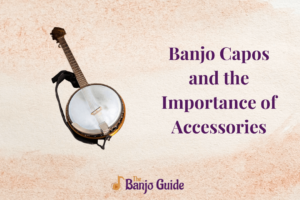If you happen to play a stringed instrument such as a guitar then, you must already know by now that you can easily pick up on playing any other stringed instrument. One of the best things about music is that since it has no languages or barriers so, you can easily pick up on learning another stringed instrument along with the guitar. Banjo and Ukulele can be two other great choices for you.
Although the basic mechanics of these two instruments are almost the same but on the whole, these two instruments have two different dynamics and bring a different feel to the music. So, let us know more about the Banjo and Ukulele and their differences.
Similarities And Differences Between A Banjo vs Ukulele
The Origin Of Banjo And Ukulele
A Ukulele is said to have come from Braguinha. During the Nineteenth century, the Portuguese brought this guitar-like four-stringed instrument to Hawaii.
While Banjo was a part of the African-European traditional music. This folk instrument belongs to the family of instruments called Akonting, which came to the US along with the slaves of West Africa.
The Construction
Banjo: This instrument has options from four strings to six strings that are stretched over a circular body that looks like a drum. Even though earlier the Banjos were made using the body of a gourd and a neck from a wooden stick but a lot has changed about this instrument over the past few eras.
The circular rim in the modern pot of a Banjo is made using either metal or wood. And just like a drum, it is also given a tension head too. It stretches over the pot supported by brackets. Traditionally, animal skin was used in making this head but now synthetic materials are used. Even though the neck of the Banjo is made of wood preferably mahogany, walnut or maple but, the rest of the instrument is a mix of different materials. This gives the instrument a distinct sound and identity.
Just like a guitar, it has different strings ranges, starting from four to six. Even when you look at the size of a Banjo, you will see it is a lot bigger than a Ukulele. There are two types of Banjos that you will get one with a closed back and the other with an open back.
Ukulele: An Ukulele happens to be a replica of an acoustic guitar but much smaller in size. To a common man, it may resemble a toy guitar but, this instrument is much more serious and has great music to offer. Different varieties of wood are used in creating the body of this instrument. For making other smaller parts in it, various other metals or plastic are used.
The body of a Ukulele has a fixed shape that almost resembles the number eight, just like an acoustic guitar. But these days other varieties of Ukulele are made too. Some have a paddle shape, square, and even an oval shape, commonly called a pineapple.
Sound Of The Instruments
The materials used in creating the strings of both the Banjo and the Ukulele impacts greatly to their sound. Usually, a Ukulele’s sound is far sweeter than a Banjo. The wooden body of this instrument gives it a bright and warm Hawaiian tone. While Banjos have a very distinct metallic and twang tone to their sound. This is what also makes Banjo a more expensive instrument than a Ukulele.
Even though there goes around a misconception that the sound is the same for a Banjo and a Ukulele, but, it is not. Banjos use steel strings whereas Ukuleles use nylon strings and this creates a difference in their sounds. The sound of a Banjo is more appropriate for bluegrass, folk, and country music. These days even in hip-hop, rock, and pop music it is being used too. Ukulele is more popularly played for island music. But it is also used for blues, rock, and jazz as well. Guitarists are more familiar with the sound of the Ukulele than a Banjo because rosewood, koa, mahogany, and maple wood are generally used for making a Ukulele.
Tuning Of The Instruments
Because Banjos and Ukuleles use different types of strings, the process of tuning them is different too. The most popularly used Banjo is the five-string one and it is tuned in open D which leads to the cords GDGBD. The fifth string which is close to the nose of the instrument is the shortest one. It is also called the thumb string or the drone because it is not fretted but is plucked with the thumb.
A Ukulele uses the GCEA standard for tuning. It is similar to the tuning of the four upper-range strings of the guitar. The highest four strings range the cords from DGBE up to GCEA. The lowest strings are tuned up to G. Because the G and A are far apart so an additional octave is also used. Apart from that there are also alternative methods of tuning both instruments too.
The Chords
The chords both in a Banjo and a Ukulele are different. Surely you can play the same chords in both instruments but their sounds shall be different. You can never expect a chord of Banjo to give the same effect in Ukulele and vice versa. There are methods of alternate tuning in both instruments which makes the instruments overlap one another for establishing the chords.
You can even establish the chord between a five-string Banjo with a traditional four-string Ukulele. For example, the G chord in both instruments shall be the same. So, basically, the same tuning of the instruments shall not work in both instruments. In each of the instruments, you have to tune differently for establishing the same chord.
Techniques In The Learning Of The Instruments
Both a Banjo and Ukulele are different looking and different sounding stringed instruments so, learning how to play them is different too. Although a guitar player can be able to play them as he is familiar with the chords but, surely there are different techniques to their learning. Learning of playing the instruments comes from where you are coming from. For example, according to the Chicago tuning, the Banjo has a tenor while Ukulele has a baritone.
If you are a beginner to stringed instruments you shall find it’s a little easier to learn and play a Banjo over a Ukulele. In a Banjo the wires are much lighter and thinner making it easier for strumming and pushing down. But again those who are familiar with acoustic guitars find it easier to learn to play the Ukulele. They say the nylon strings in it are much softer and so it does not hurt like the steel strings of a Banjo. some even say the short neck of the Ukulele and fewer strings make it easier to learn.
Final Thoughts About Banjo vs Ukulele
Where the choice of instruments is concerned, it depends on the perspective of the individual. People who love stringed instruments or are musicians play each of these instruments based on the composition they are working on. Although both a Banjo and Ukelele are stringed instruments but, they are different in every way. The structure and materials used in both these instruments are different.
The type of strings used in them are different too and this is why the sounds they deliver are different as well. Even where tuning is concerned, you cannot tune both instruments in the same manner. A more commonly used Banjo is a six-stringed one while a traditional Ukulele has four strings. So, the same tuning of both instruments shall not apply while you are trying to create a similar sound. Both these instruments add a different feel to the sound and so, it is used in different genres of music.
Some may find it easier to learn a Ukulele while others may say a Banjo is easier to learn especially if both of them are beginners. But, if you observe you will find that each of these instruments has a unique sound to offer. And it depends on the choice of the individual to which sound he is more drawn to.
FAQs:
1. Does a Banjo uses the same chord as Ukulele?
You cannot transfer the chords of a Banjo directly to a Ukulele and neither a Ukulele to a Banjo. For establishing the same chords on these two different instruments, you have to tune them differently.
2. Is a Banjo easier to learn than a Ukulele?
An acoustic guitar player shall find it much easier to learn a Ukulele as he is more familiar with its technique and sound. While a beginner may find it easy to learn a Banjo. So, it differs for each individual on which instrument he is more attracted to.
3. Can I create the sound of a Banjo on the Ukulele?
A Ukulele uses nylon strings while a Banjo uses steel and metallic strings. Sometimes musicians use steel strings on a Ukulele to bring out the sound of Banjo from it. If not completely, but up to a certain extent, it is possible to make the sound from a Ukulele like a Banjo. There shall always be a little difference because apart from the strings, the Ukulele is made using solid wood while a Banjo is made differently. The drum of it is made using a different material which creates its unique sound resonance.
4. Which is easier to play in Banjo Vs Ukulele?
Both of these instruments are easy to learn. You have to take out time to learn and practice. The basic versions of these instruments are almost similar to each other. If the question is very specific that which one is easier to play among ukulele or banjo, the answer would be a banjo. A banjo is somewhat more manageable to play than a ukulele.
5. What is the difference between a ukulele and a banjo?
The very fundamental difference in Banjo Vs Ukulele that you can immediately catch up on is the shape of both these instruments. A banjo is available in 4-strings, 5-strings, and 6-strings. On the other hand, a ukulele has 4-strings. The sound that you would hear out of a banjo would be very pleasant, calm, give countryside vibes, and a warmer tone but with a ukulele, the sound would be very cheerful, exciting, and fun.
The strings of ukulele are generally made of nylon and the strings of a banjo are made of metal. A ukulele is lighter in weight than a banjo. Ukuleles are high-pitched and a banjo is more on the calmer and warmer side of the music. The strumming or playing pattern of a banjo is easier than a ukulele. If you know how to play the guitar, the ukulele would appear to be a piece of cake to you.




